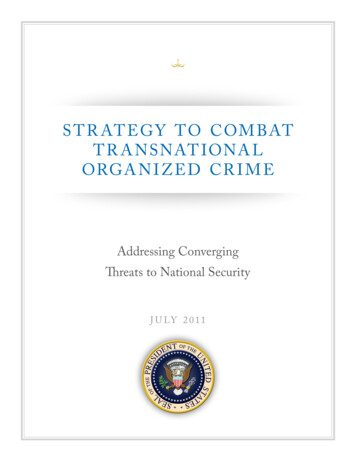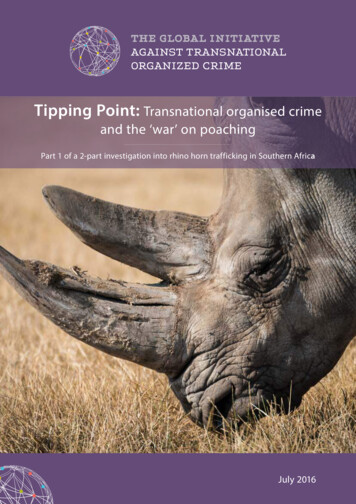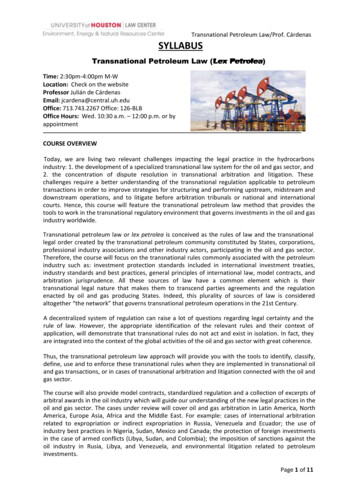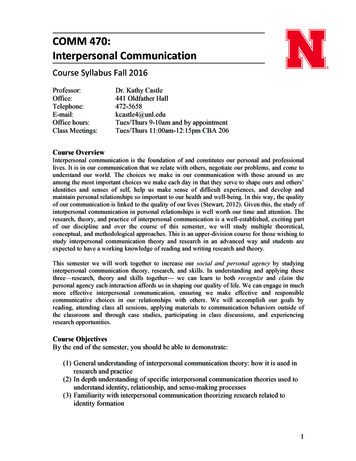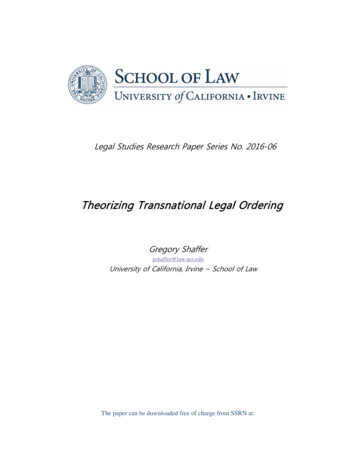
Transcription
Legal Studies Research Paper Series No. 2016-06Theorizing Transnational Legal OrderingGregory Shaffergshaffer@law.uci.eduUniversity of California, Irvine School of LawThe paper can be downloaded free of charge from SSRN at:
Theorizing Transnational Legal OrderingBy Gregory Shaffer,Chancellors Professor, UC Irvine School of LawLaw encounters, responds to, and shapes an immense amount of transnationaleconomic and social exchange. As information processing and communicationtechnologies revolutionize, transnational social interaction and interdependencedeepen. Transnational knowledge practices and social risks spread. Time and spacecompress.The response to these changes has been a dramatic increase in what can beviewed as transnational legal ordering. Much theorizing of transnational legalordering revolves around three mismatches: those between global markets andnational law; between public law capabilities and private demands; and betweenprivate lawmaking and public goals (Mattli 2015). The first spurs legal ordering thatis transnational in its geographic scope. The second drives private lawmakingthrough private contract and private regulation. The third catalyzes hybrid forms oflawmaking, involving international hard and soft law, private legal ordering, andtheir interaction. These developments challenge the traditional concept of thenational public sphere for the making of law (Fraser 2014).Jessup’s 1956 Storrs Lecture is widely cited as first giving prominentattention to the concept of “transnational law,” which he defined as “all law whichregulates actions or events that transcend national frontiers.” Jessup’s conceptreflected a functional concern that the combination of national and international lawis inadequate to regulate transnational activities. He thus included in his concept, inaddition to public and private international law, “other rules which do not wholly fitinto such standard categories.” Yet he did not significantly develop that residualcategory of “other rules.” Since then, scholarly interest in the phenomenon oftransnational and global legal ordering has grown dramatically. In 2015, fifteenjournals used the term “transnational law” or “transnational legal” in their title, andthat number expands to forty journals when including the terms “global law” or“global legal.”1These figures are based on a search of the WorldCat database on January 15, 2016. The searchcreated a much larger list of journals that we edited after reviewing it (on file with author).1
Although scholarship increasingly refers to transnational law and legalordering, it is often vague regarding what these terms encompass, so that theproliferating literature has become a jungle without a map. A theory of transnationallegal ordering should define its terms so that it is amenable to theoretical scrutinyand empirical engagement. Halliday and Shaffer (2015), for example, define theterms “transnational,” “legal,” and “order” for purposes of engaging in multidisciplinary, empirically grounded theory building and application. They contendthat a transnational legal order seeks to produce order in an issue area that actorsconstrue as a problem, uses law to address the problem, and is transnational in itsgeographic scope. They stipulate that a transnational order is legal insofar as itadopts legal form to address a problem, its norms are produced or conveyed inconnection with a transnational legal body or network, and/or it directly orindirectly engages national legal bodies. By order, they refer, sociologically, toshared norms and institutions that orient social expectations, communication, andbehavior. By transnational, they signify ordering that transcends and permeatesnation-state boundaries. Yet, as we will see, there remains considerable variation inthe use of these terms.This review essay is cartographic in laying out the current state oftransnational legal theorizing and application of such theories. Its aim is to provide aclearer understanding of this proliferating field. The essay categorizes and evaluatesthree theoretical approaches to transnational legal ordering that respectively (i)assess private legal ordering through private contract, private regulation, andprivate dispute settlement (covered in Part I); (ii) analyze the recursive interactionof public and private norm-making and practice at the transnational, national, andlocal levels that (potentially) give rise to transnational legal orders transcending,permeating, and transforming nation-states (examined in Part II); and (iii) criticallyreconfigure the concept of law (addressed in Part III).Before we turn to these approaches in detail, let me make a reflexive caveaton this essay in light of transnational processes more generally. The scholarshipreviewed was in English or is translated into English, and the majority of it byscholars from the Global North. In part, this reflects the subject of study sinceEnglish has become the lingua franca of the commercial, financial, and economicworld that drives much transnational legal ordering, and scholars from non-nativeEnglish-speaking countries increasingly publish in English, especially when writingon transnational topics. And yet, critically, this mapping exercise reflects a challengefor mapping exercises more generally. Since scholarship tends to reflect where onesits, there is a need to publish and include theorizing and empirical application oftheory by scholars from different backgrounds, and in particular those from theGlobal South (Rodríguez-Garavito 2015; Santos 2014).2
I. Transnational Legal Ordering as Private Legal OrderingA first group of scholars focuses solely or predominantly on private legalordering in theorizing the transnational. Most of them maintain that the state lacksthe will, capacity, or efficiency to create, apply, and enforce law for the coordinationand regulation of behavior. This theorizing is grounded in the nature of the actors(private actors) and the form of legal ordering (private contract, standard setting,assessment, and enforcement), giving rise to “a-national” law or “law beyond thestate” (Carbonneau 1998; Michaels 2007). The theorists can be broken down intothree sub-groups: (i) law and economics scholars who focus on privately-madecommercial law, or lex mercatoria, as a more efficient and optimal form oflawmaking and dispute settlement; (ii) socio-legal scholars who evaluate privateregulation by business and civil society groups; and (iii) private international lawscholars who address private international law as a backdrop to private legalordering which is either complicit or protective of public values.Many private law scholars traditionally have viewed law as coming fromsociety as opposed to from the state (Michaels and Jansen 2007), and they havebeen particularly prominent in developing transnational legal theory that focuses onthe role of private actors. Much of this work has focused on the role of commercialactors in lawmaking and enforcement today. Private professionals developstandards across sectors through standard form contracts and standard-settingorganizations, whether independently or through government delegation (Bütheand Mattli 2011; Schepel 2005). Lloyds of London sets re-insurance law, theInternational Accounting Standards Board (IASB) accounting rules, the InternationalSwaps and Derivatives Association (ISDA) master agreements for derivatives, andthe International Chamber of Commerce (ICC) rules for letters of credit (Levit 2005;Morgan 2006; Botzem and Quack 2006; Shaffer 2009). Private actors are central tothe development of rules governing the internet, called lex informatica, sport, calledlex sportiva, and commerce, called lex mercatoria. Online companies create onlineconsumer protection standards, coupled with methods of payment, security,certification, and online dispute settlement (Calliess and Zumbansen 2010).Governments create commissions composed of private professionals to createcorporate governance codes that the state does not codify but backs by mandatorydisclosure requirements regarding them (Calliess and Zumbansen 2010). This turnto theorizing private transnational law reflects an analogous turn in the socialsciences to the study of “governance” in contrast to “government” (Djelic and SahlinAndersson 2006).The rise of commercial arbitration as privatized dispute settlement has beencentral to driving this approach (Dezalay and Garth 1996; Gaillard 2010; Hale 2015).Today, a substantial proportion of private contracts contain an arbitration clause,which can be deployed in over 200 arbitration centers around the globe (Stone3
Sweet 2006). A community of elite lawyers and arbitrators populate this field(Dezalay and Garth 1996; Karton 2013). The field’s professional culture is one inwhich private arbitrators service transnational business as its agents, in contrast tojudges appointed through public processes by a state or international organization(Karton 2013). States, which can be viewed as “competition states” in regulatorycompetition with each other (Cerny 1997; Genschel and Seelkopf 2015), further thisprocess by competing to attract arbitration business through national laws andinternational treaties that limit state interference with arbitral rulings. Althoughenforcement of arbitration awards formally depends on national courts, nationalcourts reputedly are used to enforce only a small percentage of them so thatprivatized dispute settlement appears semi-autonomous in practice (Calliess andZumbansen 2010, 122). We, however, lack reliable data given the confidentialnature of most awards.1. Law and Economics of the New Lex Mercatoria. A group of theoristsworking in the law and economics tradition focus solely on commercial actors in thebottom-up, spontaneous creation of transnational legal orders. They maintain(although against significant contention from historians)2 that modern forms oftransnational legal ordering have long roots, reflected in the lex mercatoria (or lawmerchant) developed as custom by private guilds and commercial traders duringthe Middle Ages before the ascent of nation-states (Milgrom, North & Weingast2000). They contend that we are now witnessing the rise of a “new law merchant”grounded in private contract and commercial arbitration (Cooter 1996).The law and economics approach to transnational legal ordering stresses theoptimality of private ordering because of reduced transaction costs and theinadequacy of state-based law for the modern business community (Cooter 1994;Dalhuisien 2000; Hadfield 2001, 2009a), whether for innovation contracts (Gilson etal 2013), global supply chains (Gereffi and Lee 2012), just-in-time manufacturing,finance (Dalhuisen 2000), or otherwise. Cooter (1996, 1643) maintains that in acomplex, rapidly changing economy, “efficiency requires decentralization [oflawmaking] to become more important,” giving rise to a new law merchantinvolving “specialized business communities,” in which law “arises outside of thestate’s apparatus.” Hadfield (2001) goes further, contending that, in order to avoidthe complexity and transaction costs of the public law system (including its choice oflaw rules), decentralized privatized regimes for commercial law should competeHistorians contest the idea that lex mercatoria during the Middle Ages was based on uniform,universal merchant custom (Kadens 2012, 2015). Kadens (2012) insists that the historical evidenceshows that it was based on private ordering through contract where local custom and regulationwere used to address gaps.24
against each other (including regarding their lawmaking, adjudication, andenforcement systems), so that companies may choose among them. Shedistinguishes law’s economic function from its justice function, maintaining that itseconomic function is to provide structure “for the operation of efficient markets,”and is paramount in commercial law governing commercial relations (2001, 40).For these theorists, transnational private regimes exist when private partiesare the source of the law’s content (contract and background private rules), disputesettlement services are privately provided (such as arbitration), and the legitimacyof the legal order is based on the parties’ consent (as opposed to public lawmaking’sdemocratic status). The authors and subjects of law are thus the same — privateparties. Public law, at best, provides Hayekian background rules to facilitate efficientprivate ordering, but Hadfield (2009a) contends that the background rules forcommercial law should be privatized as well. Private actors are codifyingcommercial norms through long-standing organizations such as the ICC andUnidroit (Michaels 2007; Berger 2010), but private legal service companies could, intheory, compete with and displace them. In this way, law would not only reflect andsupport global capitalism, but itself become a commodity. Although state lawauthorizes party autonomy to contract out of state-based systems, the empirical,socio-legal question becomes whether such state authorization is needed for thecreation of a transnational legal order (Glenn 2005).2. Private Social Regulation. A second sub-group of private lawmakingtheorists challenge the first sub-group’s focus on efficiency because it elidesquestions of power, consent, externalities, and the mismatch of global markets andpublic interest regulation (Calliess and Zumbansen 2010; Cutler 2003; Muir Watt2011, 2014). These theorists examine the role of private lawmaking that has anexplicit regulatory purpose (Cafaggi 2011; Calliess and Zumbansen 2010; Wood et al2015). They analyze transnational private regulation of the social by the social.This second sub-group of theorists explicitly addresses private lawmaking inits broader regulatory dimensions, applying the logic of private lawmaking beyondcommercial law to all areas of regulatory protection developed by the social welfarestate during the 20th century. Such areas include labor law (Backer 2016), humanrights law (Backer 2005, 2007), environmental law (Meidinger 2009; Perez 2011),consumer law (Calliess and Zumbansen 2010), and financial law (Black and Rouch2008; Miller and Cafaggi 2013). Much of the resulting regulation is of a soft-law(voluntary) nature, exemplified by the United Nations Guiding Principles onBusiness and Human Rights (or “Ruggie Principles”). It thus contrasts with the hardlaw for commerce and investment grounded in binding contract enforced througharbitration, backed by courts (Cutler and Dietz 2016). Yet, such transnational softlaw can be, and at times is, transformed into binding requirements through5
transnational supply chain contracts, giving rise to new “transnational regulatoryregimes” that affect power relations among private parties (Cafaggi 2013; Cafaggiand Pistor 2014).Business and civil-society networks drive such legal ordering. Much of foodsafety depends on private regulatory regimes developed by retailers where supermarket chains, like Walmart and Sainsbury, create their own private food safetystandards and enforce them through private contract (Chalmers 2003; Meidinger2009). These standards are often developed through private standard settingnetworks, such as GLOBALG.A.P, which incorporate transnational soft law such asthe Hazard Analysis and Critical Control Points (HACCP) guidelines published by theUnited Nations Food and Agricultural (FAO), and which are enforced throughcontract. Private standard-setting organizations themselves are often governed bytransnational soft law standards, such as those set forth in the ISO/IEC Guide forcertifications schemes published by the International Organization forStandardization. Sustainable forestry regulation, for example, is driven bytransnational civil society developed regimes, such as the Forest StewardshipCouncil (FSC), which mandates that certification bodies comply with the ISO/IECGuide. FSC’s substantive standards, in turn, are enforced by retailers, such as HomeDepot, that require compliance with FSC’s certification system as a condition forpurchasing lumber (Cashore et al 2004).In these areas of social regulation, private actors serve as lawmakers,adjudicators, and enforcers, giving rise to what can be viewed as functionallydifferentiated transnational private regulatory legal orders. These transnationallegal orders fill significant gaps in national legal systems that have limited resourcesto monitor global firms and supply chains (Cafaggi 2013). They rely on privatestandards and contracts, certifiers to provide the functional equivalent ofadjudication, and enforcement through market exclusion, whether by industryconcerned with the firm’s reliability, or by retailers out of fear of consumer boycottsamplified by the media (Backer 2007). Such private regulation creates a form oftransnational harmonization whose jurisdictional scope is defined functionally (interms of the subject area in question) rather than territorially. The result is asectoral fragmentation of transnational law that contrasts with the hierarchicalunity of nation-state territorial legal orders (Kjaer 2014; Karton 2016). Suchtransnational private legal ordering has regulatory and distributive effectsimplicating third parties, giving rise to analysis of their legitimacy, accountability,quality, and effectiveness (Black 2008; Cafaggi 2014).These theorists divide in their treatment of non-state law. Some theorizedevelopments in terms of the marginalization of state law and the autonomy ofprivate legal ordering in light of the complexity of modern society and the decline ofstate capacities (Teubner 1992, 1997; Calliess 2004), while others assess the6
interaction of private regulation with state law, including as a supplement orcomplement (Michaels 2007; Wood et al 2015; Cafaggi 2015), giving rise to themutual increase of state-based and privately-made law (Kjaer 2014). Some of theselatter theorists are covered as well in Part II regarding the interaction of public andprivate actors in the transnational construction and conveyance of legal normsacross levels of social organization.3. Private International Law Conceived as a Regulatory Device. A third subgroup of private law theorists has parallels with the second sub-group in that eachbuilds on the work of Karl Polanyi to contend that the economy must be embeddedwithin society (Joerges and Falke 2011). This third sub-group, however, theorizes adifferent way that this embedding can occur — that of private international law andits choice of law techniques to govern transnational activities. Private internationallaw consists of national law addressing the questions of jurisdiction, applicable law,and recognition and enforcement of judgments, including arbitral awards. It thusgoverns the interface of different national legal systems and private ordering. Thisapproach views transnational legal ordering in terms of the decentralized interactionof nation-state legal systems in relation to private ordering (Wai 2005; Michaels andJansen 2006; Muir Watt 2014; Whytock 2009). Since this sub-group is linked totraditional state conceptions of legal ordering it could be included under the secondapproach addressed in Part II. It is included here because it comprises private lawscholars who directly interact with decentralized theories of private transnationallegal ordering, including regarding the state’s complicity in them.This group of private international law scholars contends that privateinternational law can counter the “liftoff” of transnational business law as anautonomous field outside public regulatory control (Wai 2002). They critiqueconventional private international law theorists who maintain that privateinternational law is “apolitical” and “neutral” in advancing the aims of private partyautonomy. As Muir Watt (2011, 2014) writes, private international law is complicitif it accords business rights to self-organize while shielding business from duties,thus granting it immunity and impunity. National courts do so when they applyprivate international law to recognize and enforce arbitral awards that includepublic law claims, such as consumer, labor, human rights, antitrust, and securitieslaw claims. They do so when they permit vulture funds to seize the assets of poor,financially distressed countries in sovereign debt defaults, and even siphon offdevelopment aid. And they do so when they fail to provide jurisdiction againstmultinational companies for their human rights and environmental abuses abroad(Muir Watt 2011).These theorists view semi-autonomous lex mercatoria commercial regimes ina dialectical relationship with national regulatory law. For them, although there is7
“transnational liftoff” of business, there must also be “juridical touchdown” ofnational law to account for those affected by transnational business activities (Wai2002), which they view as private international law’s regulatory dimension (MuirWatt 2011). Michaels (2007) thus contends that theorists are empirically wrongwhen suggesting that the lex mercatoria is “a-national,” at least from the perspectiveof the state. The state remains part of transnational legal ordering, whether as anaccomplice, facilitator, enforcer, or check. But the state is only a part of suchordering, which, in transnational perspective, entails “law beyond the state”(Michaels 2007).II. Transnational Legal Ordering as Transnational Construction, Flowand Settlement of Legal NormsA second, broader approach toward theorizing transnational legal orderingincorporates both public law and privately made norms and institutions. It thusparallels Jessup’s conception of transnational law as comprising public and privateinternational law and such “other rules which do not wholly fit into such standardcategories.” Yet this approach parts from Jessup in focusing not on transnational lawas a body of law, but rather on the processes through which legal norms areconstructed, flow, settle, and unsettle across levels of social organization, from thetransnational to the local (Halliday and Shaffer 2015).The approach builds concepts for empirical study of the different stages oftransnational legal ordering. In particular, it assesses the framing, emergence,propagation, contestation, resistance, settlement, institutionalization, nesting,decline, and fall of transnational legal orders (Halliday and Shaffer 2015b). Theseprocesses are top-down, bottom-up, horizontal, and transversal, as legal norms areuploaded and downloaded, imported, and exported (Santos 2002; Dezalay andGarth 2002; Koh 1996, 1998, 2006; Friedman 1996), and developed in one domainto contest and shape those in another (Joerges 2011; Shaffer and Pollack 2009).Actors engage in diagnostic struggles, conflicts are papered over with contradictionsand indeterminacies, and “actor mismatch” arises between those who diagnoseproblems, negotiate legal texts, and implement and apply them, so that “problems”remain and can give rise to new, recursive cycles of lawmaking (Halliday andCarruthers 2007). Over time, these processes can lead to normative settlementscomprising new working equilibria regarding the appropriate legal norms andinstitutions to order particular issues. One can point to a transnational legal orderwhen the legal norms concord across levels of social organization (Halliday andShaffer 2015a, 2015b; Block-Lieb and Halliday 2015). Figure 1 provides a simplifieddepiction of these processes.[add figure 1 (from the end) here]8
For these theorists, the term “transnational” does not suggest the withdrawalor disappearance of states as major actors in transnational governance, nor thattransnational processes are autonomous of national law and institutions. Rather,they stress the following points: first, that much legal ordering transcends nationstates; second, that states and state institutions are far from the only importantactors in law-making beyond the state; and third (and critically), that to understandtransnational legal ordering, one should assess the interaction of lawmaking andpractice across different levels of social organization, from the transnational to thelocal. Such an approach addresses the production of legal norms and institutionalforms, their migration across borders, the role of intermediaries in these processes,and contestation and homologies among the transnational, national, and local levels(Dezalay and Garth 2002; Shaffer 2013).This approach thus explicitly incorporates public lawmaking and publicinternational law within its analytic scope (Jessup 1956; Halliday and Shaffer 2015;Shaffer 2015a). As public international law opens to non-state parties, such as in theareas of human rights, crime, trade, and investment, and as international courtsexpand in their jurisdiction and exercise increased interpretive authority (Alter et al2016), international law contributes more directly to transnational legal orderingacross domains of social life. Public international law harmonizes even parts ofprivate international law, giving rise to transnational legal orders of particulargeographic and substantive scope on choice of law and enforcement questions(Whytock 2016). As states delegate greater public powers and informal normmaking to supranational organizations and transgovernmental networks, statesbecome agencies that implement rules of extra-state origin (Glenn 2005). Theseprocesses are particularly pronounced regionally in the European Union, but arealso developing elsewhere. Transgovernmental networks are often central to theseprocesses involving exchanges among networks of agencies from states whosesovereignty is “disaggregated” (Slaughter 2004). Such disaggregation reflectsfunctional differentiation of lawmaking within the state itself (cf. Teubner and Korth2012; Kjaer 2014).This approach also encompasses private lawmaking and its interaction withpublic law within a single analytic frame, such that governance becomes pluralist,multi-polar, and heterarchical (Ladeur 2004). Abbott and Snidal (2008) develop theconcept of a “governance triangle” in the production of environmental, labor, andhuman rights standards, where the triangle’s three points are states (at timesoperating through international organizations), firms (at times operating throughtrade associations), and non-governmental organizations (at times operatingthrough NGO coalitions). Individual initiatives can be plotted within the triangle as afunction of the actor or combination of actors engaged. These initiatives compete,9
overlap, conflict, borrow, and coordinate with each other at different phases of theregulatory process, involving agenda-setting, norm formation, implementation,monitoring, enforcement, and review (Wood et al 2015).3Public international law contributes to the development of transnationalprivate regulation on account of international law’s weaknesses as well as itsconstraints. For example, on the one hand, the 1992 UN Conference on Environmentand Development failed to adopt binding international rules for sustainable forestry,creating a regulatory gap. On the other hand, while individual states could attemptto address this gap within their jurisdictions, they were constrained by otherinternational rules, those of the General Agreement on Tariffs and Trade (GATT).After Austria was pressed to remove an import ban against unsustainably harvestedlumber in order to avoid a GATT challenge, it helped finance a private certificationsystem for sustainable lumber that became the Forest Stewardship Council. TheInternational Tropical Timber Organization, formed by the same 1992 UNConference that failed to create substantive standards, eventually endorsed suchprivate standard and certification systems (Bartley 2007).Private and public actors directly and indirectly negotiate with each other, sothat transnational private regulation can be viewed in the shadow of public law, and(to turn the conventional metaphor on its head) public law can be viewed in theshadow of transnational private regulation. At times, states steer and “orchestrate”non-state governance initiatives (Abbott et al 2014), but one may question who attimes does the orchestrating (Braithwaite and Drahos 2000). Public law oftenfollows transnational private lawmaking, whether by incorporating and validatingprivate standards, acquiescing to them, or complementing and supporting them,such as through disclosure requirements and fair trading laws. At times, state lawimplements private standards, as in the case of financial derivatives lawincorporating ISDA standards, or securities law incorporating privately developedIASB accounting standards. In other cases, private associations turn non-bindinginternational soft law into binding contractual obligations, such as when GlobalG.A.P.incorporates UN FAO food safety guidelines in its contracts. The public-privateinteraction is both horizontal (between transnational private associations andinternational and regional public organizations) and vertical (between transnationalprivate associations and nation-states). These processes give rise to complexmappings of transnational legal orders that vary in their substantive and geographicscope (Halliday and Shaffer 2015).At times, public and private processes provide new experimentalist architectures for governancetranscending the nation-state (de Burca, Keohane and Sabel 2013).310
This approach starts by viewing transnational legal ordering as beginningwith the framing and construction of a problem to be ordered (Halliday and Shaffer2015a; 2015b). Behaviors can exist for a long time before they are considered aproblem, so that the construction is not a natural one. Broader cultural norms oftenoperate as a form of framing that informs any conceptualization of a problem andthus any particular frame. The work of world polity theory is particularly importantin this regard since it assesses the role of such cultural processes asindivi
Chancellors Professor, UC Irvine School of Law . Law encounters, responds to, and shapes an immense amount of transnational . (IASB) accounting rules, the International Swaps and Derivatives Association master agreements for derivatives, and (ISDA) the International Chamber of Commerce (ICC) rules for letters of credit (Levit 2005; .
